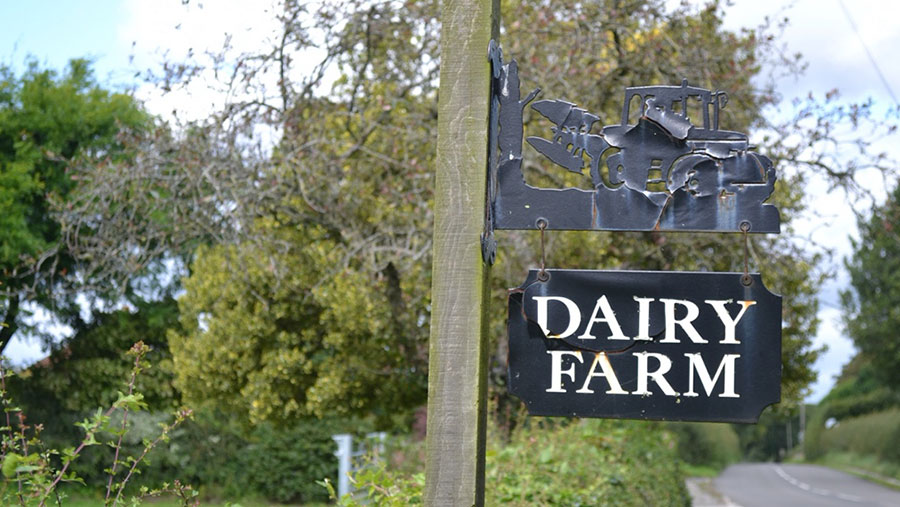Smart tools and tips for better beef finishing

“When you’re making lots of changes, it’s vital to question everything you do.”
That’s the view of Ian Norbury who, after working in construction, is now running the family farm near Knutsford in Cheshire.
His plan for Dairy Farm focuses on expanding the Angus herd, developing pedigree stock sales, achieving better carcasses quicker and driving down costs, while making the system easier for one person to operate.
Ian’s parents, Geoff and Pauline, had originally been dairy producers, later shifting to beef and keeping 60 cows when Ian returned to the 100ha (250 acre) outfit close to Manchester airport five years ago.
“I’m aiming to build the herd up to about 150-head,” explains Ian.
“I’ll then cull the lowest performing cows, so I end up with a slightly smaller ‘super group’ of cows that perform really well but require low management.”
He calved 112 cows this year compared with 70 last year, reduced the calving period from 21 to 15 weeks and now aims to finish animals for slaughter between 16 and 21 months, after one winter inside.
“I’m going to stick with Angus, because they’re low cost to run, simple to manage and easy-calving,” he says. “I love farming and am passionate about it, but the farm has to pay its way.
There’s no one silver bullet – it’s about making lots of small gains that collectively transform the farm.”

Mobberley Angus
To do this, it’s crucial to have accurate data on which to base decisions, he stresses.
“By nature, I’m an analytical person, but I want to be able to justify every decision I make. At times like now – when beef prices are low – there’s more reason than ever to make those incremental improvements.
Making better decisions doesn’t just bring me better returns, month-in month-out, but it also hopefully increases the ultimate asset value of the farm by ensuring I’m improving the land, the stock and the infrastructure.”
His figure-driven philosophy led Ian to introduce Farmplan’s Cash Manager and Cattle Manager software this year.
“You can’t use data if you haven’t collected it in the first place,” he says.
“For example, we record a lot of data connected to calving – as it’s one of our main KPIs – and we’ve been able to improve calf survival, health and growth through making decisions based on these stats.
Tightening the calving period, for instance, has enabled us to be more focused and has been genuinely life-changing.
“A few years ago, my diaries would be littered with numbers and notes connected with the stock, but they were incomplete, hard to find and often impossible to decipher. I never utilised the information properly.”
Nowadays, at-a-glance and easy-to-access information is available on every animal – everything from breeding histories and weights to medical records and TB information.
Similarly, ‘kill data’ such as prices, grades, fat classes, weights and kill-out percentages, which he gets from buyers ABP and Woodheads, is proving invaluable.
As well as for helping hit market spec, it’s critical to collect in terms of reviewing performance and selecting future sires.
Meanwhile, Ian finds Cattle Manager’s ability to populate the compulsory Food Chain Information (FCI) form, using the ‘planned sale’ functionality, really useful.
“Because all the information is already in the software, it saves time and eliminates the risk of me making any mistakes inputting it.
I can print a package of paperwork which has all the info and looks really professional, which is important as I’m working hard to build my reputation as someone producing really top-notch stock, both for slaughter and breeding.”
“As farmers, we need to focus on how we can solve problems, not just complain about the things we can’t change.
We’ve all got to get better at properly valuing our own time.
After all, I really enjoy calving, but I don’t want to be getting up to do it at two o’clock in the morning if I’m losing money. Life’s too short for that!”
Tips for improving beef finishing
“Taking the time to plan feed regimes and record results, costs and actions can provide useful information to monitor progress and help you make better management decisions,” says Rebecca Smith from Farmplan’s Software Services Team.
“Making full use of the valuable information at your fingertips can improve your profits through accurate cost management, whether that’s identifying and addressing potential issues in advance, avoiding repeated calving issues, or improving selection of productive dams.”
Here are some tips for managing beef cattle nutrition to improve animal health and boost profit margins:
Record keeping and monitoring
Accurate and detailed records can play a vital role in helping to plan feed and land management as well as track productivity for the herd.
“By keeping a record of what your animals are being fed, it allows you to see which feeds create the best results at the best costs,” says Rebecca.
“You can manage feeding and costing on a group basis if needed or break it down to an individual basis. This allows you to compare DLWG figures and discover which rations are delivering the best results.”
Costs and productivity
Costs should be allocated and monitored as part of the budget, as well as included in detailed records for individual animals.
With feed making up 70% of costs, it’s wise to seek professional advice when managing complex rations to keep costs low.
However, in general, feed can be managed based on the production system in place.
Rebecca adds: “Costs can be managed easily within a software package – such as Farmplan’s Cattle Manager – by viewing the daily cost per animal, while also allowing you to monitor grazing by recording on-farm movements.
This helps reduce overgrazing and encourages field rotation. By recording which location your animal is on, you can assess a field’s nutritional value and effectively manage weight gain.”
Choosing a good mix of nutrients, concentrates and minerals
Carefully planning feedstuffs is a reliable way to ensure better performance and health in beef cattle.
“Once the information has been recorded into the software, it’s easy to report information you require so you can monitor and highlight any problems that may occur.
It’s better to be aware at an early stage, so you can monitor your best feed plan and reduce expenses”, says Rebecca.
Efficient use of resources, for example home-grown forage and grass, can play an important role in improving the productivity and profitability of the herd.
Careful planning can help ensure weight gain and body condition are maintained, whilst reducing costs associated with adding further nutrients to the diet.
